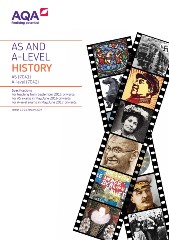2R The Cold War, c1945–1991
This option provides for the study in depth of the evolving course of international relations during an era of tension between communist and capitalist powers which threatened nuclear Armageddon. It explores concepts such as communism and anti-communism, aggression and détente and also encourages students to reflect on the power of modern military technology, what hastens confrontation and what forces promote peace in the modern world.
Part one: to the brink of Nuclear War: international relations, c1945–1963
The Origins of the Cold War, c1945–1949
- US, British and USSR relations in 1945: conflicting ideologies; tensions at Yalta; relations between Stalin, Roosevelt and Churchill; the breakdown of the Grand Alliance at Potsdam; relations between Stalin, Truman and Attlee
- Developing tensions: the Soviet Union occupation/control of eastern and southern Europe; Kennan's Long Telegram; the Iron Curtain speech; Cominform; the Greek Civil War and the Truman Doctrine on containment
- The USA’s involvement in Europe: policy towards Britain and Europe; the launch of the Marshall Plan; US attitudes to Germany and Berlin
- Conflict over Germany: developments within the sectors, including Bizonia and currency reform; the Berlin blockade; the creation of East and West Germany; formation of NATO
The Widening of the Cold War, 1949–1955
- US containment in action in Asia: the reconstruction of Japan and US-Japanese relations; support for Jiang Jieshi and policy towards China and Taiwan; the defensive perimeter strategy; support for South Korea; NSC-68
- The Korean War: causes, position and aims of Kim ll Sung and Syngman Rhee; attitudes and actions of the UN, USA, USSR and China; military involvement and settlement
- Increasing Cold War tensions: McCarthyism in the USA and its influence in Britain and Europe; US dominance in the UN and role as 'world policeman'; the isolation of China
- Alliances and shifts: FRG and NATO; the Warsaw Pact; SEATO; Eisenhower, Dulles and 'brinkmanship'; the domino theory; attitude to French struggle in Indo-China; the Geneva Conference
The Global War, 1955–1963
- Khrushchev and East-West relations: impact of risings in Poland and Hungary and Soviet intervention; the degree of 'peaceful coexistence', including exchange of visits and Paris summit
- Cold War rivalries: the extension of the arms race including ICBMs; the space race; sputnik and space flight; the Berlin Crisis and the U2 affair; the significance and impact of the Berlin Wall
- Conflict in Asia: Indo-China under Ho Chi-Minh in the North and Diem in the South; formation of NLF; Kennedy's policies towards Indo-China and Diem's assassination
- Confrontation between the superpowers: US attitudes to Cuba and developments leading to the missile crisis; the 13 days; the significance of the crisis
Part two: from Détente to the end of the Cold War, c1963–1991 (A-level only)
Confrontation and cooperation, c1963–1972 (A-level only)
- Confrontation in the Vietnam War: Johnson's policy in Vietnam; the Gulf of Tonkin resolution; escalation; tactics and relative strengths of the two sides; the Tet Offensive
- Nixon's policies in Vietnam: Vietnamisation; extension into Cambodia and Laos; relations with China; the beginning of the Paris peace talks
- Cooperation: attitudes of Khrushchev and Kennedy; Hot-line; Moscow Test Ban Treaty; nuclear non-proliferation treaty; cut back in materials for nuclear weapons
- Pressures on USSR: the crisis in Czechoslovakia and the Brezhnev doctrine; relations with China
The Brezhnev era, 1972–1985 (A-level only)
- The USA and SE Asia: Paris peace talks; Northern victory; continuing problems in Cambodia; costs of war
- The extent of Détente up to 1979: the SALT talks; Ostpolitik and Helsinki accords; arms race; relations with China
- The Second Cold War: the reasons for renewed hostilities and developments, including the Soviet invasion of Afghanistan; new personalities, including Reagan, Thatcher and Pope John Paul II; the crushing of Solidarity in Poland; the shooting down of KAL 007
- Developments in Africa and the Americas: the impact of Cuban intervention in Angola and Ethiopia; the impact of US intervention in Latin America and the Caribbean including Chile, Grenada and Nicaragua
The ending of the Cold War, 1985–1991 (A-level only)
- Gorbachev and the ending of the Cold War: pressures on and significance of Gorbachev as Soviet leader; new thinking and practicalities: the importance of Soviet economic problems;
- The summits between the USA and the USSR, including Geneva, Reykjavik, Washington and Moscow; Reagan; star wars; Bush and the US response
- The collapse of Communism in the Eastern European soviet satellite states; the end of the Brezhnev Doctrine and significance of events of 1989
- The ending of Cold War tensions in Asia: Afghanistan; the Americas: Cuba, Nicaragua and El Salvador; Africa: Angola and Ethiopia; the end of the Cold War: the Malta summit and its aftermath, including the reunification of Germany; the collapse of the USSR and resignation of Gorbachev
